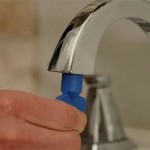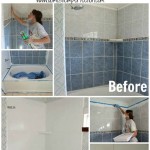How To Sand Down Bathroom Cabinets
Sanding down bathroom cabinets is a crucial step in preparing them for a fresh coat of paint or stain. This process ensures proper adhesion of the new finish, resulting in a professional-looking and durable result. Ignoring thorough sanding can lead to peeling, chipping, and an overall unprofessional appearance. This article provides a comprehensive guide to effectively sanding bathroom cabinets, covering essential tools, step-by-step instructions, and important considerations for different cabinet materials and finishes.
Before initiating the sanding process, preparation is paramount. This involves gathering the necessary tools and materials, as well as taking appropriate safety precautions. A well-prepared workspace will contribute to a smoother and more efficient sanding experience.
Gathering Essential Tools and Materials
The success of sanding bathroom cabinets depends heavily on having the right tools and materials readily available. Here's a comprehensive list:
Sanding Paper (Various Grits): Different grit levels are necessary for various stages of sanding. Coarse grit (80-120) is used for removing old finishes and imperfections. Medium grit (150-180) smooths out the surface after coarse sanding. Fine grit (220-320) preps the surface for painting or staining, ensuring a smooth final finish. A higher grit may also be required for finer sanding.
Sanding Block or Palm Sander: A sanding block provides manual control for detail work and hard-to-reach areas. A palm sander, preferably an orbital sander, speeds up the process and provides a more even sanding on larger, flat surfaces. Ensure the sander is comfortable to operate for extended periods.
Dust Mask or Respirator: Sanding generates dust particles that can be harmful to the respiratory system. A dust mask or, preferably, a respirator is essential for protecting your lungs. Choose a respirator with appropriate filtration for fine dust particles.
Safety Glasses: Protecting your eyes from flying debris is crucial. Safety glasses or goggles should be worn throughout the entire sanding process.
Cleaning Supplies: Tack cloth, mineral spirits (or a similar degreaser), and clean rags are necessary for removing dust and grease from the cabinets before and after sanding. A vacuum cleaner with a brush attachment also proves useful for removing loose dust particles during the sanding process.
Screwdriver or Drill: These tools are needed for removing cabinet doors, drawers, and hardware prior to sanding. Labeling the doors and hardware can simplify the reassembly process.
Drop Cloths or Plastic Sheeting: Protect surrounding surfaces from dust and debris generated during sanding. Cover floors, countertops, and any nearby furniture.
Painter's Tape: Use painter's tape to mask off areas that you do not want to be sanded, such as the inside of the cabinet frames or adjacent walls. This ensures clean lines and prevents accidental damage.
Preparing the Cabinets and Workspace
Proper preparation of the cabinets and workspace is essential for a successful sanding project. This involves removing hardware, cleaning the surfaces, and creating a dust-free environment.
Remove Doors, Drawers, and Hardware: Use a screwdriver or drill to detach cabinet doors, drawer fronts, and all hardware, including knobs, handles, hinges, and drawer pulls. Place all removed hardware in labeled bags to prevent confusion during reassembly. Label the doors and drawers with corresponding numbers or letters to ensure they are reinstalled in their original positions.
Clean the Cabinet Surfaces: Before sanding, thoroughly clean the cabinet surfaces to remove any grease, dirt, or grime. Use a degreasing cleaner, such as mineral spirits or a specialized cabinet cleaner, and clean rags. Pay particular attention to areas around door handles and drawer edges, as these tend to accumulate more dirt and grease. Allow the cabinets to dry completely before proceeding to sanding.
Protect Surrounding Areas: Cover the surrounding floors, countertops, and any nearby furniture with drop cloths or plastic sheeting to protect them from dust and debris generated during sanding. Use painter's tape to mask off areas that you do not want to be sanded, such as the inside of the cabinet frames or adjacent walls.
Ensure Adequate Ventilation: Sanding can generate a significant amount of dust, so it is important to ensure adequate ventilation in the workspace. Open windows and doors, and consider using a fan to circulate air. If possible, set up a dust collection system to minimize the amount of dust released into the air. Consider working outdoors if the weather permits.
The Sanding Process: A Step-by-Step Guide
The sanding process involves several stages, starting with coarse grit sandpaper to remove old finishes and imperfections, followed by progressively finer grits to smooth the surface and prepare it for painting or staining.
Start with Coarse Grit Sandpaper (80-120): Begin by using coarse grit sandpaper (80-120) to remove any old finishes, such as paint or varnish, and to smooth out any imperfections, such as scratches, dents, or uneven surfaces. Use a sanding block or palm sander for flat surfaces and a sanding block for edges and corners. Apply consistent pressure and avoid sanding in one spot for too long, as this can create unevenness. Remove the bulk of the existing finish carefully.
Switch to Medium Grit Sandpaper (150-180): Once the old finish has been removed and the surface is relatively smooth, switch to medium grit sandpaper (150-180). This will further smooth out the surface and remove any remaining imperfections. Use the same sanding technique as with the coarse grit sandpaper, but with slightly lighter pressure. This stage is crucial for creating a smooth base for the final finish.
Finish with Fine Grit Sandpaper (220-320): After sanding with medium grit sandpaper, use fine grit sandpaper (220-320) to create a smooth and polished surface. This will ensure that the paint or stain adheres properly and provides a professional-looking finish. Use light pressure and sand in the direction of the wood grain. Avoid over-sanding, as this can damage the surface.
Sanding Difficult Areas: Reach small and intricate areas that the sanding block or palm sander cannot access using folded sandpaper, sandpaper wrapped around a dowel rod, or small detail sanders. Pay attention to corners, edges, and moldings. Sanding these areas might take more patience and time. Take care not to damage intricate designs.
Dust Removal and Surface Preparation: After each sanding stage, thoroughly remove dust from the cabinet surfaces. Use a vacuum cleaner with a brush attachment to remove loose dust particles, followed by a tack cloth to pick up any remaining dust. Ensure the surface is completely clean and free of dust before proceeding to the next sanding stage. After the final sanding stage, wipe down the cabinets with mineral spirits or a similar degreaser to remove any residual oil or grease. Allow the cabinets to dry completely before applying paint or stain.
Inspecting the Sanded Surface: Prior to applying any finish, thoroughly inspect the sanded surface for any remaining imperfections or areas that require additional sanding. Use a bright light to highlight imperfections. Pay attention to edges, corners, and areas around hardware holes. Address any remaining issues before proceeding to the next step.
Addressing Different Cabinet Materials: Sanding techniques vary slightly depending on the type of cabinet material. Solid wood cabinets can typically withstand more aggressive sanding, while veneer or laminate cabinets require a more delicate approach. Always research the specific type of cabinet material before starting the sanding process. Veneer requires gentle sanding to prevent sanding through the thin layer.
Sanding Cabinets with Existing Finishes: When sanding cabinets with existing finishes, the primary goal is to create a smooth and even surface for the new finish to adhere to. If the existing finish is in good condition (no peeling or chipping), you may only need to lightly sand it with fine grit sandpaper to scuff the surface. If the existing finish is damaged or peeling, you will need to sand it down to the bare wood before proceeding.
By following these detailed instructions and taking the necessary precautions, you can achieve a professional-looking finish on your bathroom cabinets. Remember to take your time, pay attention to detail, and always prioritize safety. The result will be beautifully refinished cabinets that enhance the overall aesthetic of your bathroom.

How To Refinish A Bathroom Vanity Bower Power

How To Refinish Bathroom Cabinets Diy Domestic

How To Paint A Bathroom Vanity Love Remodeled

Refinish Bathroom Vanity Diy Project How To Stain Oak Cabinets

Diy Bathroom Cabinets How To Lighten Wood The Dotted Bow

Oak Bathroom Vanity Makeover Thrifted Nest

How To Paint A Bathroom Vanity Angela Marie Made

Diy Gel Stain Cabinets No Heavy Sanding Or Stripping Maison De Pax

How To Paint Bathroom Cabinets Without Sanding 8 Vital Steps Grace In My Space

How To Paint Bathroom Cabinets Secrets For A Perfect Finish
Related Posts







